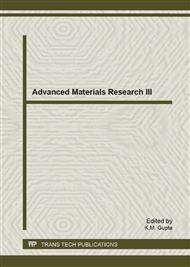[1]
S.U.S. Choi, Enhancing thermal conductivity of fluids with nanoparticles, Developments and Applications of Non-Newtonian Flows. FED-vol 231/MD vol- 66, (1995), 99–105.
Google Scholar
[2]
J.A. Eastman., S.U.S. Choi, S. Li, L.J. Thompson, Anomalously increased Effective thermal conductivities of ethylene glycol-based nanofluids containing copper nanoparticles, Appl. Phys. Lett, 78, (2001) 718–720.
DOI: 10.1063/1.1341218
Google Scholar
[3]
J.A. Eastman, S. Lee, S.U.S. Choi, S. Li, Enhanced thermal conductivity through the development of nanofluids, Materials Research Society Symposium – Proceedings, vol. 457, Materials Research Society, Pittsburgh, (1997), 3-11.
Google Scholar
[4]
S. Lee, S.U.S. Choi, S. Li, J.A. Eastman, Measuring thermal conductivity of fluids containing oxide nanoparticles, Journal of Heat Transfer 121 (1999) 280–289.
DOI: 10.1115/1.2825978
Google Scholar
[5]
X. Wang, X. Xu, S.U.S. Choi, Thermal conductivity of nanoparticle–fluid mixture, Journal of Thermophysics and Heat Transfer 13 (4) (1999) 474– 480.
DOI: 10.2514/2.6486
Google Scholar
[6]
Y. Hwang, J.K. Lee, C.H. Lee, Y.M. Jung, S.I. Cheong, C.G. Lee, B.C. Ku, S.P. Jang, Stability and thermal conductivity characteristics of nanofluids, Thermochim. Acta 455 (1-2) (2007) 70–74.
DOI: 10.1016/j.tca.2006.11.036
Google Scholar
[7]
S. Iijima, Helical microtubules of graphitic carbon, Nature 354 (6348)(1991) 56–57.
DOI: 10.1038/354056a0
Google Scholar
[8]
Choi, S. U. S., Zhang, Z. G., Yu,W., Lockwood, F. E., and Grulke, E. A., Anomalously Thermal Conductivity Enhancement in Nanotube Suspensions, Applied Physics Letters, 79, (2001) 2252– 2254.
DOI: 10.1063/1.1408272
Google Scholar
[9]
J.M. Li, Z.L. Li, B.X. Wang, Experimental viscosity measurements for copper oxide nanoparticle suspensions, Tsinghua Sci. Tech. 7 (2) (2002) 198–201.
Google Scholar
[10]
Y. Ding, H. Alias, D. Wen, R.A. Williams, Heat transfer of aqueous suspensions of carbon nanotubes (CNT nanofluids), International Journal of Heat and Mass Transfer 49 (1–2) (2005) 240–250.
DOI: 10.1016/j.ijheatmasstransfer.2005.07.009
Google Scholar
[11]
B.C. Pak, Y. Cho, Hydrodynamic and heat transfer study of dispersed fluids with submicron metallic oxide particle, Experimental Heat Transfer 11 (1998) 151–170.
DOI: 10.1080/08916159808946559
Google Scholar
[12]
K.S. Hwang, S.P. Jang, S.U.S. Choi, Flow and convective heat transfer characteristics of water-based Al2O3 nanofluids in fully developed laminar flow regime, International Journal of Heat and Mass Transfer 52 (2009) 193–199.
DOI: 10.1016/j.ijheatmasstransfer.2008.06.032
Google Scholar
[13]
M. Chandrasekar, S. Suresh, A. Chandra Bose, Experimental studies on heat transfer and friction factor characteristics of Al2O3/water nanofluid in a circular pipe under laminar flow with wire coil inserts, Experimental Thermal and Fluid Science, 34 (2010) 122-130.
DOI: 10.1016/j.expthermflusci.2009.10.001
Google Scholar
[14]
Gwon Hyun Ko, Kyoungyoon Heo, Kyoungjun Lee, An experimental study on the pressure drop of nanofluids containing carbon nanotubes in a horizontal tube, International Journal of Heat and Mass Transfer, 50 (2007) 4749-4753.
DOI: 10.1016/j.ijheatmasstransfer.2007.03.029
Google Scholar
[15]
Weerapun Duangthongsuk, Somchai Wongwises, Heat transfer enhancement and pressure drop characteristics of TiO2–water nanofluid in a double-tube counter flow heat exchanger, International Journal of Heat and Mass Transfer 52 (2009) 2059-2067.
DOI: 10.1016/j.ijheatmasstransfer.2008.10.023
Google Scholar
[16]
A.K. Nayak , M.R. Gartia, P.K. Vijayan: An experimental investigation of single-phase natural circulation behaviour in a rectangular loop with Al2O3 nanofluids, Experimental Thermal and Fluid Science 33 (2008) 184-189.
DOI: 10.1016/j.expthermflusci.2008.07.017
Google Scholar
[17]
Drew, S.L. Passman, Theory of Multi Component Fluids, Springer, Berlin, 1999.
Google Scholar


